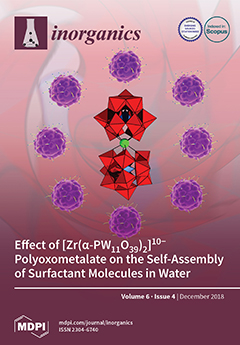Proceeding our initial studies of compounds with formally dative TM→Si bonds (TM = Ni, Pd, Pt), which feature a paddlewheel arrangement of four (
N,
S) or (
N,
N) bridging ligands around the TM–Si axis, the current study shows that the (
N,
O)-bidentate ligand 2-pyridyloxy (pyO) is also capable of bridging systems with TM→Si bonds (shown for TM = Pd, Cu). Reactions of MeSi(pyO)
3 with [PdCl
2(NCMe)
2] and CuCl afforded the compounds MeSi(µ-pyO)
4PdCl (
1) and MeSi(µ-pyO)
3CuCl (
2), respectively. In the latter case, some crystals of the Cu(II) compound MeSi(µ-pyO)
4CuCl (
3) were obtained as a byproduct. Analogous reactions of Si(pyO)
4, in the presence of HpyO, with [PdCl
2(NCMe)
2] and CuCl
2, afforded the compounds [(HpyO)Si(µ-pyO)
4PdCl]Cl (
4), (HpyO)
2Si[(µ-pyO)
2PdCl
2]
2 (
5), and (HpyO)
2Si[(µ-pyO)
2CuCl
2]
2 (
6), respectively. Compounds
1–
6 and the starting silanes MeSi(pyO)
3 and Si(pyO)
4 were characterized by single-crystal X-ray diffraction analyses and, with exception of the paramagnetic compounds
3 and
6, with NMR spectroscopy. Compound
2 features a pentacoordinate Si atom, the Si atoms of the other complexes are hexacoordinate. Whereas compounds
1–
4 feature a TM→Si bond each, the Si atoms of compounds
5 and
6 are situated in an O
6 coordination sphere, while the TMCl
2 groups are coordinated to pyridine moieties in the periphery of the molecule. The TM–Si interatomic distances in compounds
1–
4 are close to the sum of the covalent radii (
1 and
4) or at least significantly shorter than the sum of the van-der-Waals radii (
2 and
3). The latter indicates a noticeably weaker interaction for TM = Cu. For the series
1,
2, and
3, all of which feature the Me–Si motif
trans-disposed to the TM→Si bond, the dependence of the TM→Si interaction on the nature of TM (Pd(II), Cu(I), and Cu(II)) was analyzed using quantum chemical calculations, that is, the natural localized molecular orbitals (NLMO) analyses, the non-covalent interaction (NCI) descriptor, Wiberg bond order (WBO), and topological characteristics of the bond critical points using the atoms in molecules (AIM) approach.
Full article





